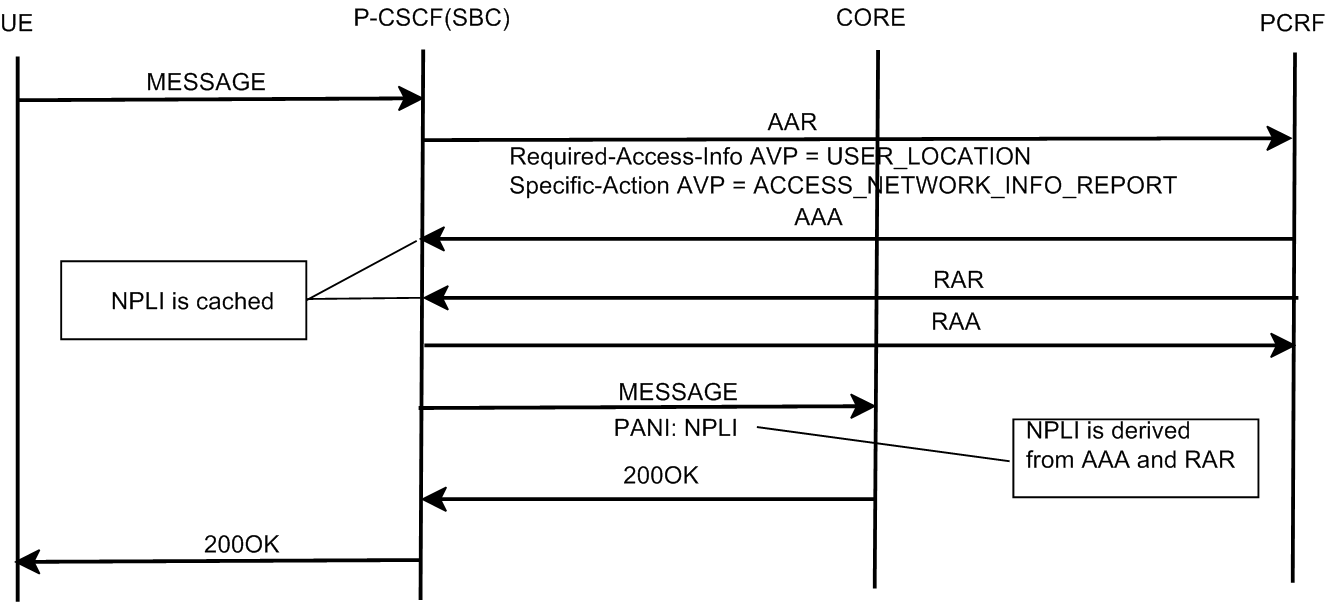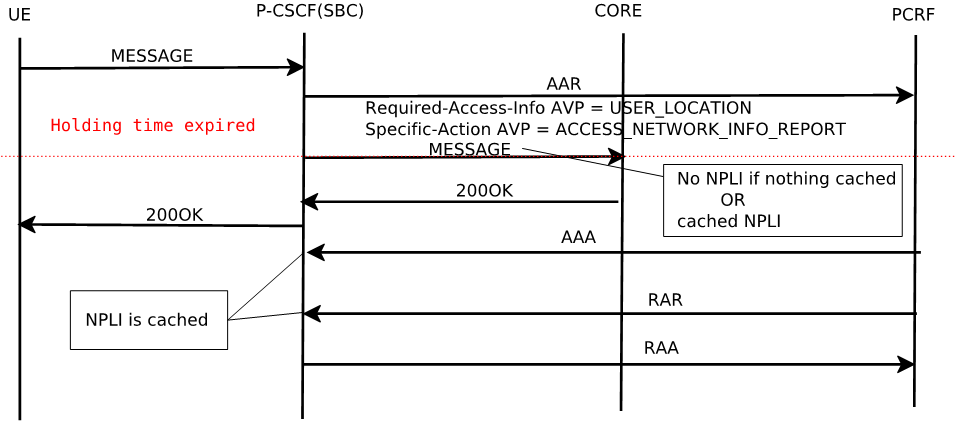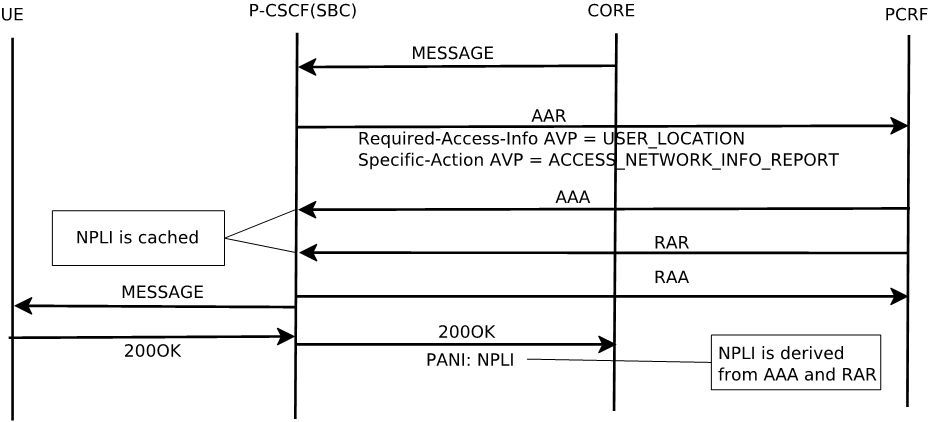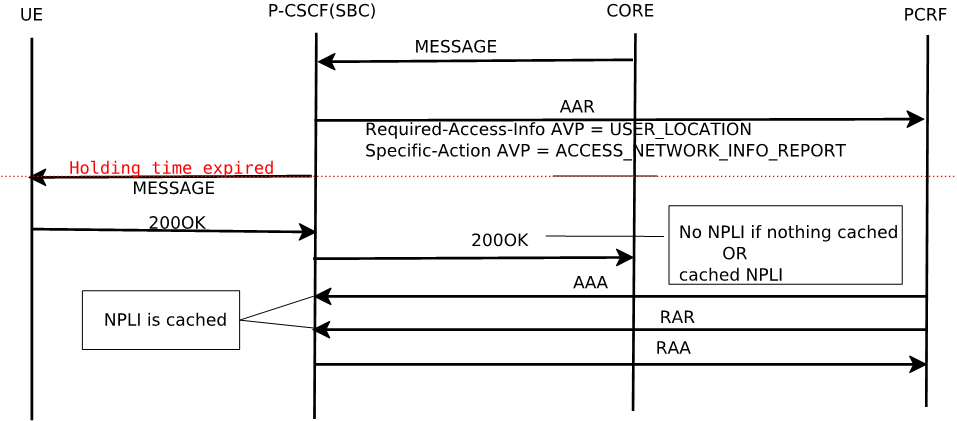Network Provided Location Information for Short Message Service
For most cases, location information is relevant at the time of the session request. Network Provided Location Information (NPLI) for SIP is delivered by DIAMETER in Authentication-Authorization Answers (AAA) and Re-authentication-Authorization Requests (RAR). In certain countries, it is a regulatory requirement to provide location information also for the Short Message Service (SMS), which in LTE networks is implemented using the SIP MESSAGE method to carry the text.
The access awareness feature in the Serving Call Session Control Function (S-CSCF) uses the P-Access-Network-Information (PANI) header in the initial MESSAGE request for selecting the registration and authentication profile RAT-type and User Location Information. This in turn depends on the access class of the IP Connectivity Access Network (IP-CAN) being used by the user equipment (UE). For that reason, the Oracle Communications Session Border Controller Proxy Call Session Control Function (P-CSCF) requires that the Authorization-Authentication Answer(AAA) from the Policy Charging and Rules Function (PCRF) to contain IP-Can, the Radio Access Technology (RAT-type) and user location information attribute value pairs (AVPs). All three values are used to populate the PANI header in the forwarded MESSAGE request according to that value.
The Oracle Communications Session Border Controller P-CSCF will map User Location Information AVP and RAT type AVP into the PANI header for all subsequent SIP messages towards the core and acknowledge the RAA to the PCRF. The np parameter will be added to the PANI header to indicate a PANI header field is provided by a network element. This content can differ from a PANI header field without this parameter, which is provided by the UE. In the case the received message by the P-CSCF already contains information provided by the UE, that information will be preserved if include-ue-loc-info is enabled.
If the location information is not received from PCRF before the holding time expires, the Oracle Communications Session Border Controller will use the default location string if it is present as default-location-string in either the SIP Interface or Realm configuration.
Registration caching has to be enabled, e.g. registration-caching=enabled, for this feature to work. NPLI will be cached on a per-contact basis.
The msghold-for-loc-info object must be set to a non-zero value for this behavior. The location information will be held for no longer than the value set in cache-loc-info-expire unless the keep-cached-loc-info-after-timeout option is set
If this feature is disabled (i.e. msg-hold-for-loc-info = 0), SMS messages will not be held for NPLI and PANI headers will not be present in the SMS MESSAGEs. There is no need to set cache-loc-info-expire in this case.
NPLI for Short Message Service Examples
The following scenarios illustrate theOracle Communications Session Border Controller behavior when the Network Provided Location Information(NPLI) is not present in cache or the cached entry has expired. There are two types of scenarios: mobile originated(MO) and mobile terminated(MT). Descriptions precede each diagram.
Figure 18-7 MO Message with AAR/AAA and RAR/RAR and within Holding Period

The below example shows a MO MESSAGE with NPLI information provided in the AAA, but the RAR arrives after the holding period expires. The NPLI value is present in the PANI header
Figure 18-8 MO Message with AAR/AAA but RAR arrives after Holding Period

MO MESSAGE with no NPLI or cached NPLI. Both AAA and RAR arrive after the holding period expires.
Figure 18-9 MO Message with no/cached NPLI; both AAR and RAR arrive after Holding Period

MT MESSAGE with NPLI provided in AAA and later updated with RAR. Both AAA and RAR arrive within the holding period. The NPLI value is present in the PANI header in 200OK response.
Figure 18-10 MT Message with NPLI in both AAR/AAA and RAR/RAA within the Holding Period

MT MESSAGE with NPLI provided in AAA, RAR arrives after the holding period expires. The NPLI value is present in the PANI header in 200OK response.
Figure 18-11 MT Message with NPLI provided in AAR/AAA, RAR arrives after Holding Period

MT MESSAGE with neither NPLI nor cached NPLI. Both AAA and RAR arrive after the holding period expires.
Figure 18-12 MT Message with no NPLI; both AAA and RAR arrive after the Holding Period

Network Provided Location Information present in Cache Examples
The following scenarios describe the Oracle Communications Session Border Controller behavior when the Network Provided Location Information (NPLI) is present in the cache.
MO MESSAGE cached NPLI value present in PANI header as the cached NPLI is current. Note that there is no AAR/AAA/RAR/RAA exchange.
Figure 18-13 MO Message with cached NPLI in PANI Header

Mobile terminated(MT) MESSAGE cached NPLI included in PANI header as the cached NPLI is current. Note that there is no AAR/AAA/RAR/RAA exchange
Figure 18-14 MT Message with cached NPLI in PANI header

'



